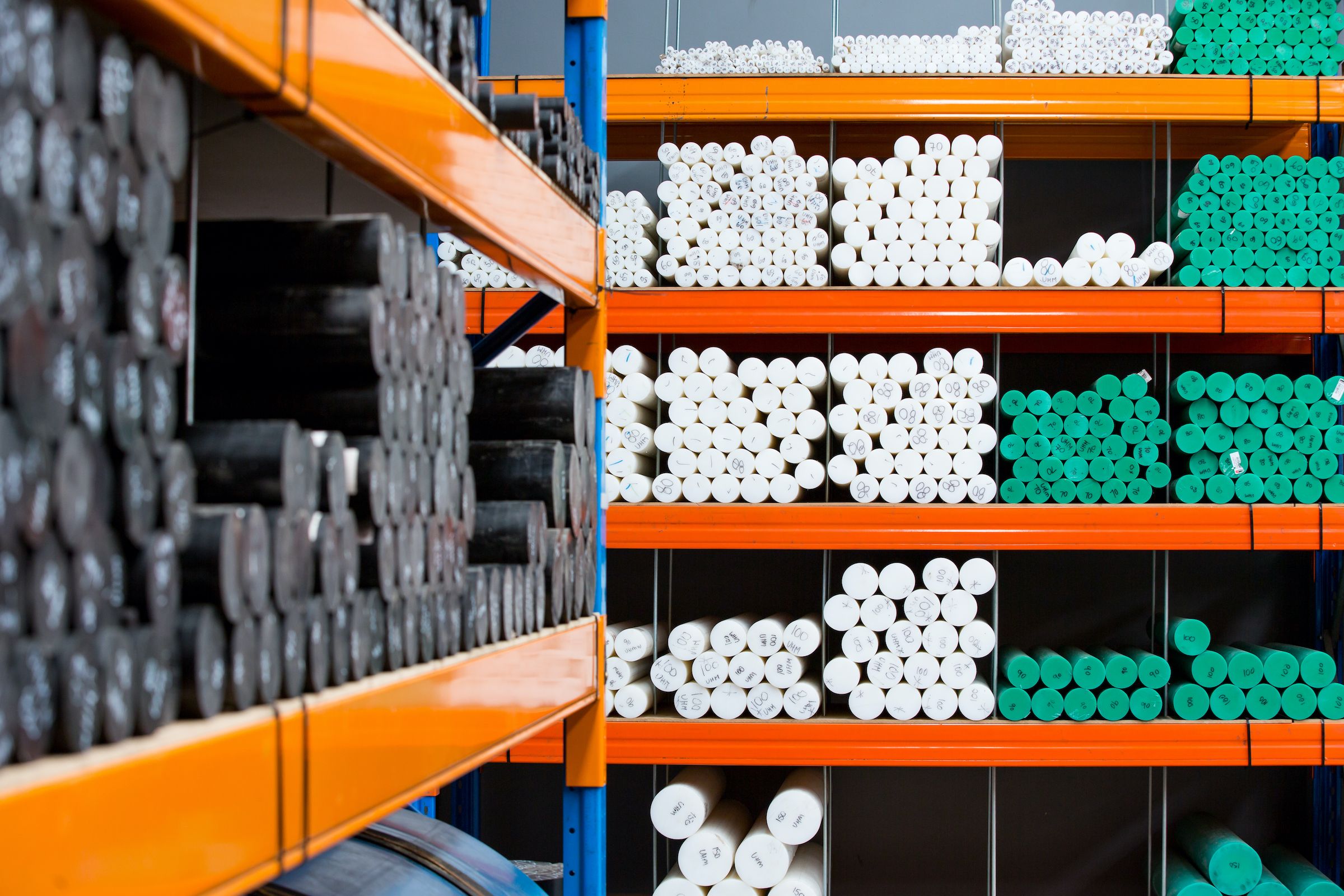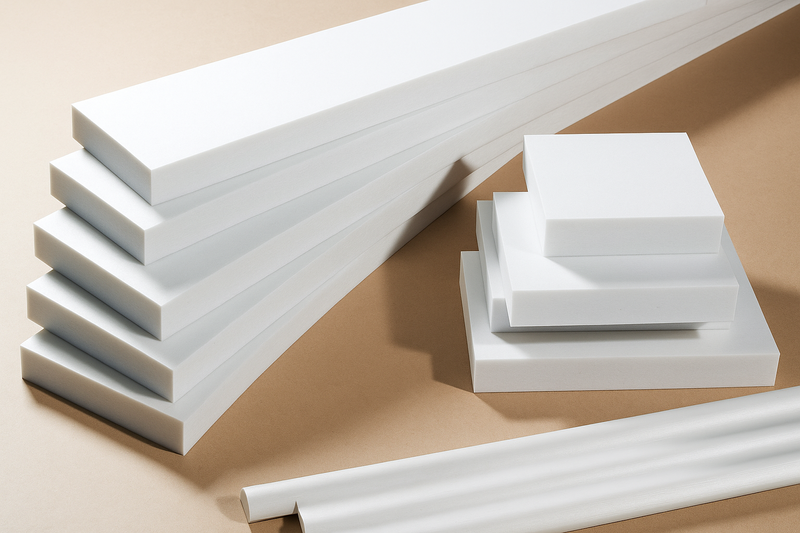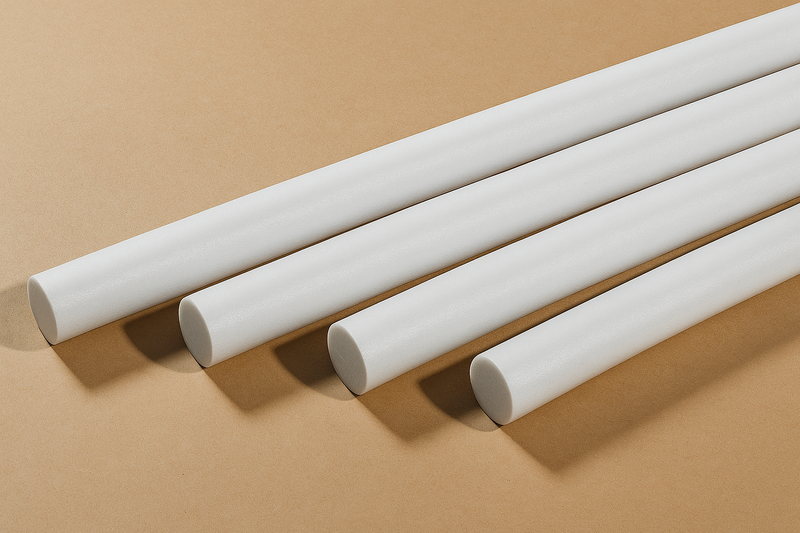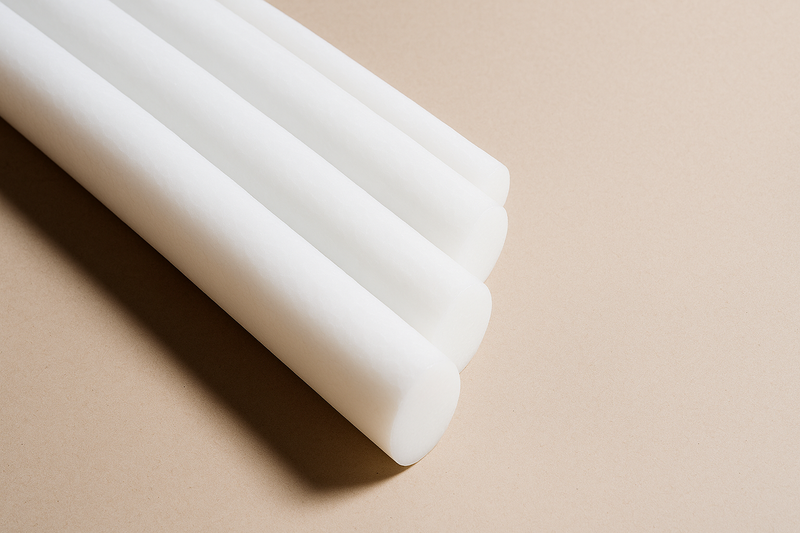At a glance
- HDPE (High-Density Polyethylene) is a commonly used engineering plastic across various industries.
- It offers excellent machinability, impact resistance, low moisture absorption, and UV stability (when stabilised).
- It’s used for creating pipes, tanks, wear parts, and food-grade components due to its strength, cost-effectiveness, and low moisture absorption.
High-Density Polyethylene, or HDPE, is one of the most widely used thermoplastics in industrial and commercial manufacturing today.
This engineering plastic is known for its durability and resistance to chemicals, corrosion, and UV radiation. Moreover, it is more affordable compared to polycarbonate, Polyetheretherketone (PEEK), PTFE, and Acetal. All of these factors make HDPE a go-to option. Despite the benefits, understanding its properties is essential before using it in any industry.
This blog covers everything you need to know about HDPE plastics, their properties, and how they can be used in different applications and industries.
What Is HDPE Plastic?
HDPE (High-Density Polyethylene) is a petroleum-based thermoplastic made from long chains of ethylene with minimal branching. This compact molecular structure results in a dense and rigid material with exceptional mechanical strength and resistance to wear and chemical exposure.
HDPE is commonly used in multiple industrial and commercial applications due to its unique benefits compared to other polyethylene variants. For instance, while LDPE (Low-Density Polyethylene) is more flexible, it’s less durable than HDPE. On the other hand, UHMWPE (Ultra-High Molecular Weight Polyethylene) offers superior impact resistance but is comparatively expensive.
In essence, HDPE plastic is the best choice if you are looking for a balance of strength and cost-effectiveness in your product design and manufacturing.
Read More: Understanding the Longevity of Different Engineering Plastics
Key Properties of HDPE
Here are some of the key properties of HDPE, making it a popular choice for various applications:
- High Strength-to-Density Ratio: HDPE offers excellent rigidity and mechanical strength despite its low weight. This makes it suitable for structural components and load-bearing uses that require weight reduction. Some examples include pipelines, containers, and transport-related equipment.
- Chemical and Corrosion Resistance: HDPE exhibits resistance to most chemicals. For instance, it does not react with acids and alkalis. This results in durability in applications that involve contact with chemicals and corrosive materials.
- Impact Resistance: HDPE offers high impact resistance. Therefore, it’s perfect for creating products that need to withstand mechanical stress, vibration, impact, or repeated use. Products like wear strips, bins, playground equipment, baskets, and protective covers can be produced using HDPE to resist impact.
- Low Moisture Absorption: Unlike many materials, HDPE doesn’t swell or degrade in humid conditions. HDPE has very low water permeability, which helps it maintain stability in wet and marine environments.
- UV Resistance with Stabilisers: Standard HDPE can degrade in direct sunlight due to exposure to UV light. However, UV-stabilised grades, often pigmented black, can resist weathering for years. This makes it suitable for outdoor infrastructure, agricultural equipment, and roofing materials.
- Easy Machinability and Weldability: HDPE can be easily cut, routed, and welded without cracking or splintering. Its workability reduces fabrication time, tool wear, and production cost. This makes it ideal for custom components or site-fabricated parts.
- Customisability: HDPE can be easily moulded into sheets, rods, pipes, and custom parts with various industrial methods. Processes like extrusion are used for creating pipes, injection moulding for detailed components, and rotational moulding for hollow items like tanks and containers, respectively.
- Non-Leaching: Many HDPE grades comply with FDA and food safety standards, making them safe for use in kitchens, food processing, and potable water systems. The material is non-leaching when certified as food-grade, meaning it won’t release harmful substances into food or liquids under repeated use.
Read More: Understanding the Impact of Molecular Weight on Engineering Plastics Performance
Common Applications of HDPE Plastic
HDPE is one of the most commonly used engineering plastics in industrial and commercial applications. Here are some of its common use cases.
Pipes and Fittings
HDPE is a preferred material for water, gas, and chemical pipelines thanks to its high chemical resistance and low moisture absorption. Its strength and lightweight make it easy to handle and install.
Unlike alternatives like metals, it resists corrosion even when installed underground or in chemically aggressive environments. This also reduces frequent plumbing requirements for maintenance and replacements, making it ideal in commercial and industrial installations.
Storage Tanks and Liners
HDPE’s chemical resistance and structural integrity make it a reliable material for manufacturing chemical tanks, containers, and process liners. It performs consistently in harsh industrial and treatment environments, such as exposure to corrosive fluids and temperature fluctuations.
Moreover, HDPE can be fully recycled. This means it supports sustainability goals in large-scale applications that require a large amount of material.
Marine and Agricultural Products
HDPE is well-suited to marine, agricultural, or any setting where the product will be exposed to moisture, UV radiation, and mechanical wear. Stabilised HDPE withstands prolonged sunlight without degrading, and its low moisture absorption prevents swelling or weakening in damp conditions.
Because HDPE is lightweight, you can easily handle and install equipment like irrigation channels, bin liners, dock floats, and feed silos. Moreover, its abrasion resistance enables it to perform reliably in agriculture involving soil, water, fertilisers, and grains.
Cutting Boards and Food-Safe Components
Food-grade HDPE is widely used in commercial kitchens and food processing facilities due to its chemical stability, impact resistance, and non-porous surface. It doesn’t absorb moisture or harbour bacteria. So, it’s easier to sanitise than wood or other porous materials.
Common applications of HDPE in food-safe components include cutting boards, benchtop liners, and food handling trays.
Electrical and Telecommunications Channels
HDPE has an excellent dielectric strength and non-conductive nature. These properties make it the right material for insulating and protecting electrical and telecommunications cables. It is reliable in underground and high-exposure installations as it can prevent the lines from moisture damage and electrical interference.
The material’s flexibility allows easy directional changes during installation, while its corrosion resistance ensures longevity in soils, coastal regions, and chemically harsh environments.
Read More: Why Engineering Plastics Are the Backbone of the Manufacturing Industry
In conclusion, HDPE offers strength, chemical resistance, machinability, and affordability, which are the ideal properties for a wide range of plastic applications. This makes HDPE one of the most versatile thermoplastics.
So, if you are looking for a sturdy and affordable engineering plastic for industrial and commercial applications, consider using HDPE.
Connect to a reliable engineering plastic supplier, such as ePOL, for the highest-quality HDPE plastics in Australia. We make them available online in the form of sheets and rods, and according to your required sizes.
So, order them now using our easy-to-use online portal, or contact us to know more about the product.
Frequently Asked Questions (FAQs)
Is HDPE plastic safe for food contact?
Yes, many HDPE grades are FDA-approved and are widely used in food processing, storage, and handling applications.
Can HDPE plastic be easily welded or fabricated?
Yes, HDPE is known for its excellent weldability and can be fabricated using various welding methods, including heat welding, extrusion welding, and butt welding. This makes it suitable for producing custom industrial components.
Does HDPE perform well in outdoor environments?
HDPE offers good weather and UV resistance, especially when UV-stabilised grades (such as black HDPE) are used. It is often used in outdoor piping, tanks, and marine applications.
Is HDPE recyclable?
Yes, HDPE is one of the most widely recycled plastics. Moreover, HDPE requires less energy and resources for recycling.








